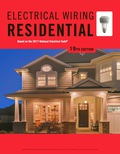
EBK ELECTRICAL WIRING RESIDENTIAL
19th Edition
ISBN: 9781337516549
Author: Simmons
Publisher: CENGAGE LEARNING - CONSIGNMENT
expand_more
expand_more
format_list_bulleted
Textbook Question
Chapter 2.2, Problem 12R
Where is access to the attic provided? __________________________________________
Expert Solution & Answer
Want to see the full answer?
Check out a sample textbook solution
Students have asked these similar questions
Please no AI response.
I have uploaded the rules, please explain step by step and which rule you have applied
I have uploaded the rules, please explain step by step and which rule you have applied
Chapter 2 Solutions
EBK ELECTRICAL WIRING RESIDENTIAL
Ch. 2.1 - What is the purpose of specifications?Ch. 2.1 - Refer to the specifications in the back of this...Ch. 2.1 - What is done to prevent a plan from becoming...Ch. 2.1 - Name three requirements contained in the...Ch. 2.1 - Prob. 5RCh. 2.1 - What phrase is used when a substitution is...Ch. 2.1 - What is the purpose of an electrical symbol?...Ch. 2.1 - Prob. 8RCh. 2.1 - Prob. 9RCh. 2.1 - What three parties must be satisfied with the...
Ch. 2.1 - What does a plan show about electrical outlets?...Ch. 2.1 - Prob. 13RCh. 2.1 - Prob. 14RCh. 2.1 - Prob. 15RCh. 2.1 - Prob. 16RCh. 2.1 - Prob. 17RCh. 2.1 - Prob. 18RCh. 2.1 - Prob. 19RCh. 2.1 - What methods may be used to mount luminaries to an...Ch. 2.1 - What advantage does a 4 in. octagon box have over...Ch. 2.1 - What is the size of the opening of a switch...Ch. 2.1 - Prob. 23RCh. 2.1 - Prob. 24RCh. 2.1 - Prob. 25RCh. 2.1 - Prob. 26RCh. 2.1 - Prob. 27RCh. 2.1 - Prob. 28RCh. 2.1 - Prob. 29RCh. 2.1 - Prob. 30RCh. 2.1 - Prob. 31RCh. 2.1 - Prob. 32RCh. 2.1 - Prob. 33RCh. 2.1 - Prob. 35RCh. 2.1 - Prob. 37RCh. 2.1 - Prob. 38RCh. 2.1 - Prob. 39RCh. 2.1 - Prob. 40RCh. 2.1 - Prob. 42RCh. 2.1 - Does the NEC allow metal raceways to be used with...Ch. 2.2 - Prob. 1RCh. 2.2 - What is the size of the footing for the steel...Ch. 2.2 - Prob. 3RCh. 2.2 - Prob. 4RCh. 2.2 - Prob. 5RCh. 2.2 - Prob. 6RCh. 2.2 - How far is the front garage wall from the curb?...Ch. 2.2 - How far is the side garage wall from the property...Ch. 2.2 - Prob. 9RCh. 2.2 - What is the purpose of the I-beams that rest on...Ch. 2.2 - Where is access to the attic provided?...Ch. 2.2 - Prob. 13RCh. 2.2 - Prob. 14RCh. 2.2 - Prob. 15RCh. 2.2 - Prob. 16RCh. 2.2 - What is the stud size for the partitions between...Ch. 2.2 - Who is to furnish the range hood?...Ch. 2.2 - Who is to install the range hood?...
Knowledge Booster
Learn more about
Need a deep-dive on the concept behind this application? Look no further. Learn more about this topic, electrical-engineering and related others by exploring similar questions and additional content below.Similar questions
- I have uploaded the rules, please explain step by step and which rule you have appliedarrow_forwardUsing the CCS Compiler method to solve this question Write a PIC16F877A program that flash ON the 8-LED's connected to port-B by using two switches connected to port-D (Do & D₁) as shown in figure below, according to the following scenarios: (Hint: Use 500ms delay for each case with 4MHz frequency) 1. When Do=1 then B₁,B3,B7 are ON. 2. When Do 0 then Bo,B2, B4, B5, B6 are ON. 3. When D₁=1 then B4,B,,B6,B7 are ON. 4. When D₁-0 then Bo,B1,B2,B3 are ON.arrow_forwardUse the ramp generator circuit in Fig. B2a to generate the waveform shown in Fig. B2b. Write four equations relating resistors R1, R2, R3, capacitor C and voltages Vs, VR and VA.to the waveform parameters T₁, T, Vcm and Vm- If R = R2 = R3, R₁ = 2R, C = 1 nF, Vcm = 2 V and Vm = 1 V, T₁ = 2 μs and T = 10 μs solve for the values of R, Vs, VR and VA using your equations from part a(i). VR C +VA R3 V₂ Vo мат R1 VsO+ V₁ R₂ Figure B2a Vout Vcm+Vm Vcm Vcm-Vm 0 T₁ T 2T time Figure B2barrow_forward
- The circuit in Figure B1a is a common analogue circuit block. Explain why you would need such a circuit. Draw another circuit in which you use the current flowing in this loop to bias a common source amplifier. This circuit is not ideal for standard CMOS technologies due to threshold shift. Why? Draw an improved version of this circuit to make it better. VDD (W)P MA M3. (), REF (쁜)~ M₁ M2 lout 시~ Rsarrow_forward23bcarrow_forwardDraw the small-signal equivalent circuit of a single transistor amplifier given in figure B1b. Assume the current source to be ideal. Determine the Open-loop transfer function, pole frequency and gain-bandwidth product all in terms of transistor parameters 9m, To and CL. If the load capacitance is 1pF and the necessary unity gain frequency is 600MHz, find the gm for this transistor. V₁ V₁ CLarrow_forward
arrow_back_ios
SEE MORE QUESTIONS
arrow_forward_ios
Recommended textbooks for you
 EBK ELECTRICAL WIRING RESIDENTIALElectrical EngineeringISBN:9781337516549Author:SimmonsPublisher:CENGAGE LEARNING - CONSIGNMENT
EBK ELECTRICAL WIRING RESIDENTIALElectrical EngineeringISBN:9781337516549Author:SimmonsPublisher:CENGAGE LEARNING - CONSIGNMENT

EBK ELECTRICAL WIRING RESIDENTIAL
Electrical Engineering
ISBN:9781337516549
Author:Simmons
Publisher:CENGAGE LEARNING - CONSIGNMENT
Introduction to 8051 Microcontroller | Part 1 | Bharat Acharya Education; Author: Bharat Acharya Education;https://www.youtube.com/watch?v=2-geyR_aM28;License: Standard Youtube License